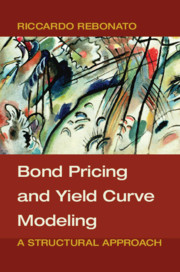Book contents
- Frontmatter
- Dedication
- Contents
- Acknowledgements
- Symbols and Abbreviations
- Part I The Foundations
- Part II The Building Blocks: A First Look
- Part III The Conditions of No-Arbitrage
- Part IV Solving the Models
- Part V The Value of Convexity
- Part VI Excess Returns
- 23 Excess Returns: Setting the Scene
- 24 Risk Premia, the Market Price of Risk and Expected Excess Returns
- 25 Excess Returns: Empirical Results
- 26 Excess Returns: The Recent Literature – I
- 27 Excess Returns: The Recent Literature – II
- 28 Why Is the Slope a Good Predictor?
- 29 The Spanning Problem Revisited
- Part VII What the Models Tell Us
- References
- Index
25 - Excess Returns: Empirical Results
from Part VI - Excess Returns
Published online by Cambridge University Press: 25 May 2018
- Frontmatter
- Dedication
- Contents
- Acknowledgements
- Symbols and Abbreviations
- Part I The Foundations
- Part II The Building Blocks: A First Look
- Part III The Conditions of No-Arbitrage
- Part IV Solving the Models
- Part V The Value of Convexity
- Part VI Excess Returns
- 23 Excess Returns: Setting the Scene
- 24 Risk Premia, the Market Price of Risk and Expected Excess Returns
- 25 Excess Returns: Empirical Results
- 26 Excess Returns: The Recent Literature – I
- 27 Excess Returns: The Recent Literature – II
- 28 Why Is the Slope a Good Predictor?
- 29 The Spanning Problem Revisited
- Part VII What the Models Tell Us
- References
- Index
Summary
Gregory (Scotland Yard detective): “Is there any other point to
which you would wish to draw my attention?”
Holmes: “To the curious incident of the dog in the night-time.”
Gregory: “The dog did nothing in the night-time.”
Holmes: “That was the curious incident.”
Sir Arthur Conan Doyle, “Silver Blaze”, in The Memoirs of Sherlock HolmesTHE PURPOSE OF THIS CHAPTER
In this chapter we present the salient features of empirical estimations of the term premia for nominal and real bonds that we have conducted using the data made available by the Fed.
For both nominal and real bonds we comment on their Sharpe Ratios, and we regress the excess returns on a small number of a-priori-chosen yield-curve– based regressors: the first few principal components (or their proxies), ‘carry and roll-down’, and all the forward rates in the problem. (We look at predictive regressions using macroeconomic variables as regressors in the next chapter.) Using as regressors all the forward rates in the problem constitutes the maximal (most general) set of yield-curve–based regressors. Barring information not contained in the prices, this regression must give the highest explanatory power of the observed excess returns. It is also the most vulnerable to overfitting. Therefore we pay a lot of attention to (i) how much worse the more austere and parsimonious regressors perform with respect to the maximal set of yield-curve regressors and (ii) how stable the predictions from the maximal set are.
Our conclusion will be that, both for nominal and for real rates, the second principal component by itself strikes a very good compromise between explanatory power (measured in terms of R2), parsimony and robustness when yield-curve–only regressors are used. As this conclusion is somewhat at odds with the most recent findings, we carefully compare our results with the recent literature in the next chapter.
UNDERSTANDING THE EMPIRICAL SETTING
The Empirical Questions
When we undertake empirical investigations of excess returns we normally try to answer two very important, and very different, questions.One is a question of dependence; the other is a question about the nature of the risk compensation. We explain what this means in this subsection.
- Type
- Chapter
- Information
- Bond Pricing and Yield Curve ModelingA Structural Approach, pp. 449 - 472Publisher: Cambridge University PressPrint publication year: 2018



